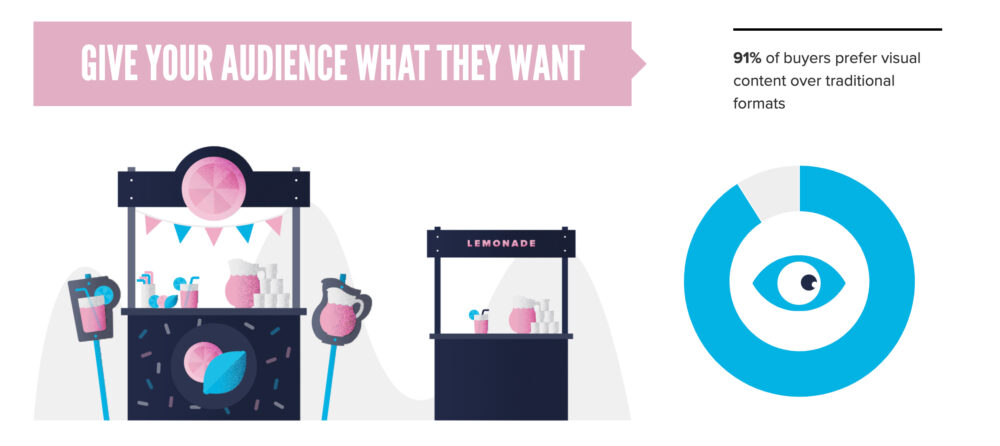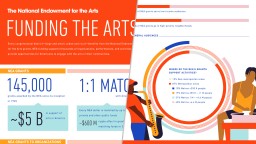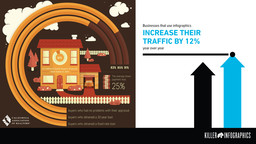More than ever before, today’s content needs to be light on text with a focus on quality visuals. But distilling your content to highlight only the most important data and information can be difficult. After all, you’re enthusiastic about what your product or service can do, and you have lots of good reasons why it’s the right fit for your target audience. However, overwhelming that audience with text can backfire. So how do you lighten up your copy without cutting valuable information? The key to identifying what content is most important is setting a single goal that you want each visual asset (or campaign) to achieve, and then only including the content that helps you achieve that goal.
1. Consider Your Audience
So you’ve set a goal: you want your motion graphic to introduce a new product, or explain why your service will, say, help businesses boost conversions by 10%. Congratulations! A single goal will ensure that your message doesn’t get muddled. Now it’s time to figure out who you’re speaking to in the first place — the more targeted and specific your demographic is, the more you can customize your copy to appeal especially to them.
Sure, 91% of buyers prefer visual content over traditional formats — it’s practically universal. But what form your content should take depends on the audience. First of all, what data and information is most and least likely to guide your audience to feel how you want them to feel and to react how you want them to react? For instance, if you’re selling a great money management tool, and you want your new motion graphic to sell that tool to twenty-somethings, you might not want to include data on how your product helps people save for retirement; instead, you can focus on how you’ve helped people pay off their college loans, or budget to buy a home.
The medium in which your message is delivered should also be determined by your target audience. Baby Boomers, for instance, are actually more likely than other generations — both older and younger — to stop engaging with content entirely when they encounter problems with it, such as the content being too long. You might want to opt for micronarratives for this group, or offer up motion graphics that only run a minute or less.
Millennial audiences also prefer bite-sized, social media-friendly visuals, and 10-second mobile ads are more appealing to them than they are to audiences aged 35-54, who prefer more traditional 30-second spots. Millennials, meanwhile, are more likely to rank content that is beautiful and entertaining as important to them, so that should not only drive your design, but your copy. Are you delivering facts in a flat tone, or are you seeking to delight and entertain? One surefire way to keep readers entertained is to involve them actively in a conversation; interactive content is a surefire way to boost time on page.
Minimize Text
It’s not just Baby Boomers — 47% of consumers will stop engaging with content altogether if it’s too long. What’s more, 44% of consumers are actually annoyed when they see poorly written or overly wordy brand content; 33% say the same for poorly designed content. Two in three consumers actually won’t purchase from a brand at all if one or more of these situations occur. So keeping your content short and well-written is absolutely essential for your brand’s success.
When you’re having trouble knowing what to cut, the first step is to look for repetition. If two stats do similar work, choose the one that makes a stronger and clearer argument on behalf of your message or goal. You need to make sure that every piece of content or data point has its own, unique purpose.
The next step (and really, essential to every step) is to remember your goal. If you’re launching a new product, customer satisfaction stats from last year might be downright irrelevant — and 42% of consumers find irrelevant brand content frustrating. So pick content that readers feel applies to them directly, and nix the rest.
Emphasize Transparency in Your Content
The most effective content is that which builds trust. Consumer trust in brands (and even news sources) is waning: 83% of consumers say that, compared to five years ago, they’re now more cautious about sharing content. So delivering transparent, fact-based content is more important than ever.
First and foremost, strong copy should cite its sources and accurately represent the facts. This ensures that your content will not only be more highly valued, but it will also be more shareable. Accuracy is the number one most important content characteristic to consumers, according to a 2018 Adobe survey. Even if the facts don’t flatter your brand as much as you would like, customers will actually like you more for it. Remember that Domino’s ad campaign in 2010, in which CEO Patrick Doyle appeared in advertisements alongside critics of the company’s pizza? Domino’s actually paid for ads in which customers declared it the “worst pizza I ever had.” Doyle also promised to turn the company around in these ads. And guess what? Since 2010, Domino’s has become the world’s second-largest pizza chain, with share prices skyrocketing from $8.76 to upwards of $220 per share. Honesty paid off.
Transparency is also about focusing on delivering useful information, rather than on making a sale. This can boost exposure: 34% of consumers will share brand content if it’s informative, not promotional. In order to ensure that you’re including content for the right reasons, try to adapt a “why culture” around every visual campaign you launch. The idea is that it’s OK — in fact, encouraged — to ask “why” at any point during a project. Ask why you’re including specific data — is it because it’ll be useful to readers, or because you’re trying to convince them? The same goes when you’re making design decisions: asking why you’re using each type of visualization will ensure that you’re optimizing the design for your goal and audience. All this cuts excess copy and visuals while focusing on producing quality content, which ranks higher on search engines and gets more social shares because, well, it’s actually earned them.
Keeping your audience in mind, in the end, is always the best way to determine what content is most important. Follow these steps, and you’ll be sure to have more customers following you.















